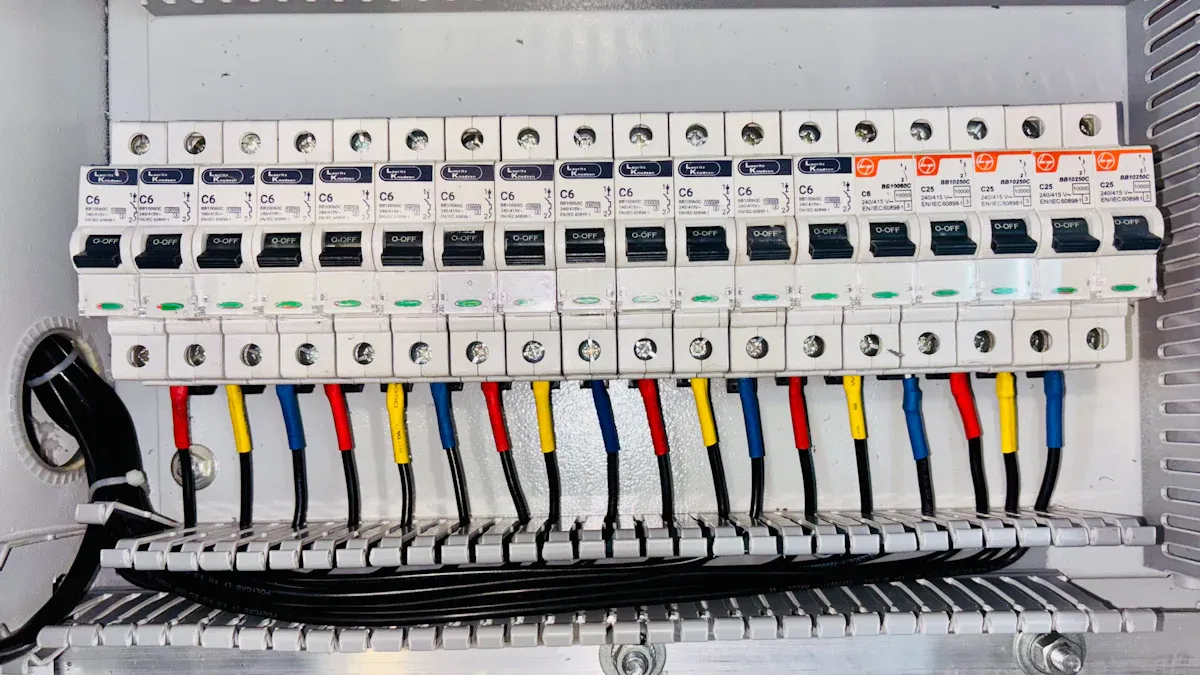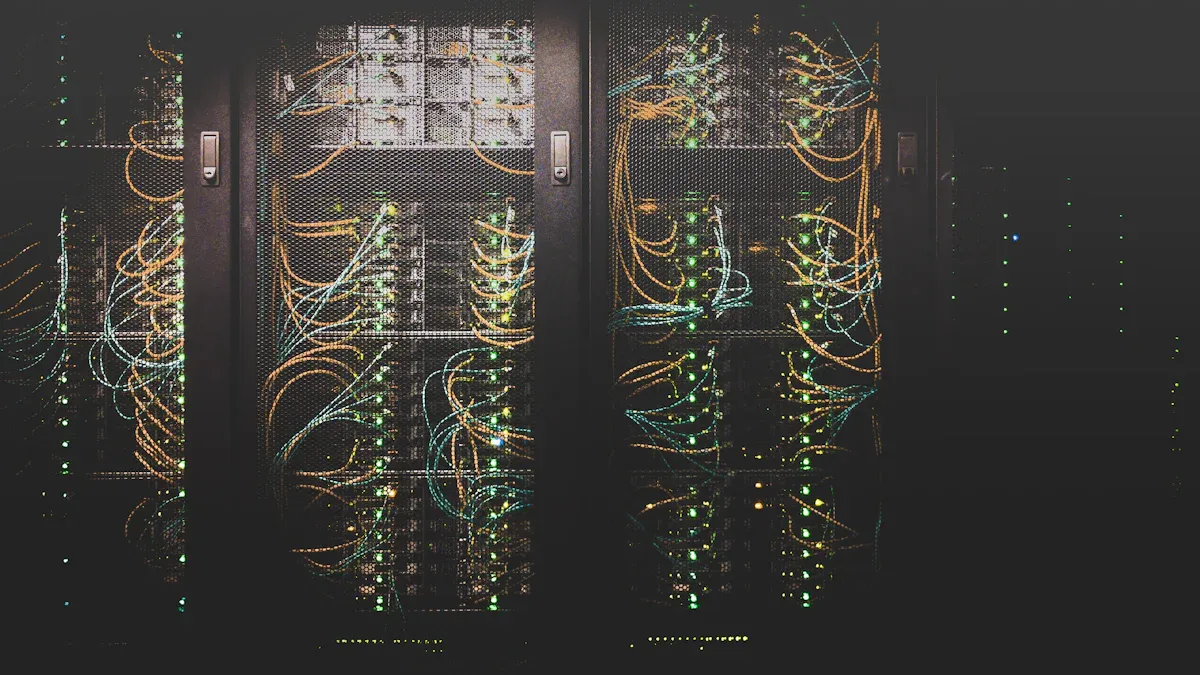
A Power Distribution Unit (PDU) delivers electricity from one source to several devices, streamlining power management in environments like data centers. The global demand for PDUs continues to rise as reliable distribution becomes essential. Features in models such as the Basic PDU and the Intelligent PDU protect equipment and improve uptime.
Key Takeaways
- Power Distribution Units (PDUs) safely deliver electricity to multiple devices, helping manage power efficiently in data centers and offices.
- Choosing the right PDU depends on your power needs, space, and budget; advanced PDUs offer remote monitoring and control to save energy and reduce downtime.
- Using intelligent PDUs improves equipment safety, lowers energy costs, and boosts reliability by providing real-time data and environmental monitoring.
Types of PDU

Basic PDU
A basic PDU serves as the foundation for power distribution in many IT environments. It delivers electricity from a single source to multiple devices without advanced monitoring or control features. Engineers design these units with fixed outlets, often using conductor wires rated between 14 AWG and 6 AWG to support a range of applications. Basic PDUs typically include circuit breakers or overload protectors to enhance safety. Technicians select compatible outlets, such as C13 or C19, and ensure the unit matches the voltage and current requirements of the equipment.
Tip: Basic PDUs work well in small offices or server rooms where cost-effectiveness and simplicity are priorities.
Metered PDU
A metered PDU adds a layer of visibility by displaying real-time load data on a local meter. This feature helps facility managers monitor power consumption and prevent overloads. Metered PDUs do not provide remote access or historical data, but they offer immediate feedback on current usage.
- Data center operators often choose metered PDUs to optimize energy use and maintain safe operating conditions.
- The market has seen increased demand for these units as organizations seek to balance cost and efficiency.
| PDU Type | Key Features | Performance and Benefits |
|---|---|---|
| Metered PDU | Local load monitoring | Real-time load data, no historical tracking |
Switched PDU
A switched PDU introduces remote control capabilities, allowing users to turn individual outlets on or off from a distance. This function enables precise management of power loads and supports troubleshooting without physical access to the equipment.
- Real-time monitoring and remote management help reduce downtime and operational overhead.
- Security features allow administrators to terminate non-critical loads during emergencies, protecting essential systems.
- High-precision measurement ensures accurate power tracking, supporting efficient energy use.
Intelligent PDU
An intelligent PDU represents the most advanced option, combining real-time monitoring, remote management, and environmental sensing. These units integrate with Data Center Infrastructure Management (DCIM) systems, providing granular data on power usage, temperature, and humidity.
- Operators can access and control intelligent PDUs from anywhere, using management software for analytics and reporting.
- Environmental sensors help maintain optimal conditions, preventing overheating and supporting sustainability.
- Case studies show that intelligent PDUs can reduce energy costs by up to 15% and improve uptime to 99.99%.
Note: The intelligent rack PDU market continues to grow, driven by the need for detailed monitoring and operational efficiency in modern data centers.
Typical Use Cases
PDUs play a critical role in various environments, from small offices to hyperscale data centers.
- Utility companies use advanced PDUs and analytics to manage distribution assets and predict equipment health.
- Data centers rely on intelligent PDUs for remote monitoring, outlet-level power data, and environmental management, especially as rack power densities increase.
- Colocation facilities benefit from PDUs with voltage flexibility, allowing them to adapt to changing requirements and reduce costs.
- The rise of AI workloads and growing data center capacity demands have made scalable, adaptable PDUs essential for efficient power distribution.
As data center electricity consumption rises, organizations increasingly depend on PDUs to ensure reliable, flexible, and safe power delivery.
Key Features and Benefits of PDU

Power Management and Protection
Effective power management and protection stand at the core of every modern data center. Engineers design PDUs with features such as surge protection, circuit breakers, and automatic transfer switches. These elements help minimize downtime risks, which can cost businesses thousands of dollars per minute. Intelligent PDUs reduce energy waste by up to 20% through real-time monitoring and adjustments.
- Automatic transfer switch PDUs increase reliability by 25% by switching power sources during failures.
- Surge protection and circuit breakers safeguard equipment and prevent costly outages.
- Environmental sensors monitor temperature and humidity, optimizing operating conditions.
Monitoring and Control Capabilities
Advanced PDUs offer real-time monitoring, metering, and remote management of individual outlets. These capabilities allow IT teams to proactively manage power consumption and maximize uptime. For example, a multinational corporation achieved a 30% reduction in energy costs within one year after deploying intelligent PDUs with monitoring and control features. Real-time alerts and remote outlet control enable immediate detection and correction of power inefficiencies, supporting operational efficiency.
Space and Cable Organization
PDUs help maintain organized server racks by providing structured power distribution. Technicians can reduce cable clutter and improve airflow, which supports cooling and equipment longevity. Organized cabling also simplifies maintenance and troubleshooting, reducing the risk of accidental disconnections.
Reliability and Uptime
A reliable PDU ensures stable power delivery to all connected devices, minimizing the risk of downtime.
- IT administrators receive alerts for proactive issue detection.
- Remote rebooting and outlet-level power sequencing prevent circuit trips and reduce downtime.
- Intelligent PDUs assist with capacity planning and quick recovery from equipment failures.
| Feature/Benefit | Evidence |
|---|---|
| Reliability Increase | ATS PDUs improve reliability by 25% in facilities with backup power. |
| Energy Waste Reduction | Intelligent rack PDUs reduce energy waste by up to 20%. |
| Enhanced Control | Switched PDUs enable remote management and minimize downtime. |
How to Choose the Right PDU
Assessing Power Requirements
Selecting the right PDU starts with a careful assessment of power needs. Facility managers calculate the total wattage of all connected devices and add a buffer for future expansion. Real-time metering provides granular data, with meter accuracy typically ranging from 1% to 5%. Including the power consumed by the PDU itself ensures accurate planning. Bi-stable relays, which consume less power and offer higher reliability, support efficient operation.
Tip: Always plan for additional sockets and modularity to accommodate future growth.
| Criteria | Description & Numerical Benchmarks |
|---|---|
| Power Capacity | Calculate total wattage; select a PDU rated above this load. |
| Number and Type of Outlets | Match device needs; provide extra outlets for scalability. |
| Input Voltage and Plug Type | Ensure compatibility with system voltage (e.g., 120V, 208V) and plug standards. |
Mounting and Installation Options
Mounting options impact both reliability and space efficiency. Rack-mounted PDUs, installed horizontally (1U/2U) or vertically (0U), remain the most common in data centers. Wall-mounted units suit compact setups, while standalone PDUs serve high-voltage industrial environments.
- Proper installation includes aligning brackets, securing with screws, and regular inspections to prevent accidental disconnections.
- Monitoring available rack units and floor space supports capacity planning and helps maintain a Power Usage Effectiveness (PUE) of 1.5 or lower.
Management and Monitoring Needs
Advanced PDUs offer remote monitoring, outlet-level control, and environmental sensors. These features enable IT teams to optimize energy use, receive real-time alerts, and maintain safe operating conditions. Intelligent models support integration with management systems, allowing proactive maintenance and reducing the risk of failures.
Budget and Future Growth
Budget planning should account for both current needs and anticipated expansion. The global PDU market is projected to grow at a CAGR of 8.8% from 2025 to 2032, driven by demand for energy efficiency and cost optimization. Investing in scalable solutions delivers long-term benefits, including improved uptime and reduced energy consumption.
Data centers rely on advanced power distribution to ensure reliable operations and future scalability.
- Real-time monitoring and surge protection prevent breakdowns and underperformance.
- Smart systems identify idle devices, optimize cooling, and support capacity planning.
| Benefit | Outcome |
|---|---|
| Energy efficiency | Reduced waste, lower costs |
| Operational reliability | Fewer outages, improved uptime |
FAQ
What is the main function of a PDU?
A PDU distributes electrical power to multiple devices, ensuring safe and organized delivery in data centers, server rooms, or industrial environments.
How does a PDU improve equipment safety?
A PDU includes features like circuit breakers and surge protection. These features help prevent overloads and electrical faults, protecting connected equipment from damage.
Can a PDU help reduce energy costs?
Yes. Intelligent PDUs provide real-time monitoring and control. Facility managers use this data to optimize energy usage and identify inefficiencies.
Tip: Regularly review PDU data to spot trends and improve energy management.
Post time: Jul-07-2025
